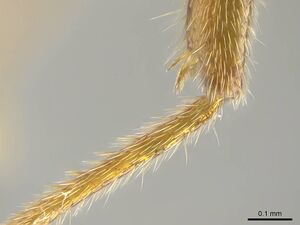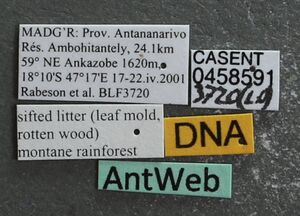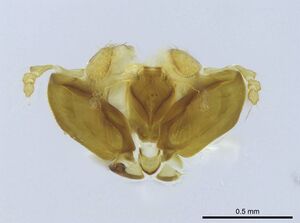Stigmatomma irayhady
| Stigmatomma irayhady | |
|---|---|

| |
| Scientific classification | |
| Kingdom: | Animalia |
| Phylum: | Arthropoda |
| Class: | Insecta |
| Order: | Hymenoptera |
| Family: | Formicidae |
| Subfamily: | Amblyoponinae |
| Tribe: | Amblyoponini |
| Genus: | Stigmatomma |
| Species group: | tsyhady |
| Species complex: | tsyhady |
| Species: | S. irayhady |
| Binomial name | |
| Stigmatomma irayhady Esteves & Fisher, 2016 | |
Stigmatomma irayhady was collected in montane rainforest habitats, above 1000 m, at the central to northern portions of the subhumid forests ecoregion of Madagascar (following the classification of Burgess et al. 2004). Specimens were recorded from sifted leaf mold, rotten wood, and in soil. S. irayhady is sympatric with Stigmatomma roahady in three localities: nearby Andranomay, close to Anjozorobe, and at the Binara Forest. It co-occurs with Stigmatomma tsyhady at the Binara Forest.
Identification
Esteves and Fisher (2016) - A member of the tsyhady complex in the tsyhady species group. Size, color, presence of genal teeth, palpal formula, presence of fenestra on the subpetiolar process, two mesotibial spurs, shape of microtrichia on posterior face of posterior metatibial spur, and absence of stout setae on the apex of hypopygium make it difficult to separate Stigmatomma irayhady from Stigmatomma roahady and Stigmatomma tsyhady.
However, S. irayhady possesses a sulcus on the anterodorsal face of the mesobasitarsus, and S. tsyhady does not; and it lacks a sulcus on the anterodorsal face of the metabasitarsus, which S. roahady has. Also, the ventral margin of the subpetiolar process decreases continuously posterad in S. roahady and S. tsyhady, while it has an obtuse angle at its midpoint in S. irayhady.
Worker with characters of the tsyhady species-group and the tsyhady species-complex, and the following characters:
1. Integument dark-brown; large-sized ant (HL: 1.07-1.14, WL: 1.37-1.55).
2. Pairs of teeth along mandible’s baso-masticatory margin have the same length along mandible’s basoapical axis, except for smaller basal teeth of dorsal row.
3. Truncated filiform setae ventrally skirting baso-masticatory margin of mandible.
4. Dorsal face of the head areolate-rugose, grading to foveolate/foveate posteriorly.
5. Palpal formula 4:3.
6. Pronotum and the dorsal face of remainder of mesosoma foveolate; propodeal lateral face scarcely foveolate; propodeal declivitous face foveolate.
7. Mesepisternum divided into anepisternum and katepisternum.
8. Basoventral three-fourths of calcar of strigil lamellar.
9. Anterior face of calcar of strigil with strap-like microtrichia.
10. Two well-developed mesotibial spurs.
11. Slit-like longitudinal sulcus present on the anterodorsal face of mesobasitarsus.
12. Two well-developed metatibial spurs.
13. Anterior face of posterior metatibial spur with sparse, small, lanceolate microtrichia; posterior face glabrous.
14. Absence of a longitudinal sulcus on metabasitarsus.
15. Sparse, blunt, stout setae present on the baso-inner face of metabasitarsus; stout setae present along the remainder inner face.
16. Subpetiolar process fin-like: half of its ventral margin obtusely angled.
Keys including this Species
Distribution
Latitudinal Distribution Pattern
Latitudinal Range: -13.26333° to -18.47333°.
| North Temperate |
North Subtropical |
Tropical | South Subtropical |
South Temperate |
- Source: AntMaps
Distribution based on Regional Taxon Lists
Malagasy Region: Madagascar (type locality).
Distribution based on AntMaps
Distribution based on AntWeb specimens
Check data from AntWeb
Countries Occupied
| Number of countries occupied by this species based on AntWiki Regional Taxon Lists. In general, fewer countries occupied indicates a narrower range, while more countries indicates a more widespread species. |

|
Estimated Abundance
| Relative abundance based on number of AntMaps records per species (this species within the purple bar). Fewer records (to the left) indicates a less abundant/encountered species while more records (to the right) indicates more abundant/encountered species. |

|
Biology
Castes
Worker
Images from AntWeb
            
| |
| Paratype of Stigmatomma irayhady. Worker. Specimen code casent0797614. Photographer Erin Prado, uploaded by California Academy of Sciences. | Owned by NHMUK, London, UK. |
    
| |
| Holotype of Stigmatomma irayhady. Worker. Specimen code casent0042899. Photographer Flavia Esteves, uploaded by California Academy of Sciences. | Owned by CAS, San Francisco, CA, USA. |
                   
| |
| Worker. Specimen code casent0458591. Photographer Flavia Esteves, uploaded by California Academy of Sciences. | Owned by CAS, San Francisco, CA, USA. |
Queen
Images from AntWeb
     
| |
| Queen (alate/dealate). Specimen code casent0458590. Photographer Erin Prado, uploaded by California Academy of Sciences. | Owned by CAS, San Francisco, CA, USA. |

| |
| Specimen code casent0458588. . | |
Nomenclature
The following information is derived from Barry Bolton's Online Catalogue of the Ants of the World.
- irayhady. Stigmatomma irayhady Esteves & Fisher, 2016: 54, figs. 35-42 (w.q.) MADAGASCAR.
- Type-material: holotype worker, 4 paratype workers, 2 paratype queens.
- Type-locality: holotype Madagascar: Antsiranana, Forêt de Binara, 9.4 km. 235° SW Daraina, 1100 m., -13.26333, 49.6, 5.xii.2003, MW25 sample transect, 5 m., BLF09800, CASENT0042899, montane rainforest, sifted litter (leaf mold, rotten wood) (B.L. Fisher); paratypes with same data but CASENT0042842, -843, -845, -847, -898, and 0797614.
- Type-depositories: CASC (holotype); BMNH, CASC, MHNG, NHMB (paratypes).
- Distribution: Madagascar.
Unless otherwise noted the text for the remainder of this section is reported from the publication that includes the original description.
Description
Worker
(holotype values within parentheses): HL: 1.07-1.14 (1.14); HW: 0.93-0.97 (0.97); HW2: 0.82-0.84 (0.84); SL: 0.58-0.61 (0.61); ML: 0.65-0.72 (0.72); WL: 1.37-1.55 (1.55); PPW: 0.60-0.69 (0.69); PtL: 0.63-0.70 (0.70); PtW: 0.68-0.76 (0.76); CI: 85-88 (85); SI: 51-54 (53); MI: 60-63 (63); PtI: 91-96 (92).
Head: Mandibular baso-masticatory margin skirted dorsally by row of filiform setae; ventrally, by truncated filiform setae. Mandibular dentition arrangement, from base to apex: single larger tooth; five pairs of teeth (each teeth pair fused basally); somewhat bifid preapical tooth; apical tooth. Most-basal tooth of dorsal teeth pairs much smaller; absent in some specimens. Anterior clypeal margin with eight to nine tubercle-like cuticular processes, arranged in a single row, armed anteriorly with asymmetrical mucronate dentiform seta. Most-lateral clypeal cuticular process with row of smaller, conic setae anterolaterally. Row of clypeal conic setae continues laterally along clypeal anterior margin, arising from flat cuticle. Median clypeal cuticular processes with almost the same length of associated dentiform setae. Long filiform setae pair on anterior clypeal margin, bordering the most central cuticular processes. Median clypeal area extending posteriorly between antennal sockets, frontoclypeal sulcus round. Supraclypeal area as shallow oval concavity. Twelve antennomeres. Genal teeth present. Widest diameter of compound eyes: three ommatidia. Palpal formula: 4:3 (four maxillary, three labial).
Mesosoma: In dorsal view, mesonotum lateral margins continuous with posterior remainder of mesosoma. Metanotal suture absent or weakly impressed. Sulcus dividing mesepisternum into anepisternum and katepisternum. Metathoracic spiracle slit-like with somewhat swollen dorsoposterior margin; preceded anteroventrally by a cuticular swell; surrounded ventroposteriorly by shallow concentric sulcus. Propodeal spiracle round, with somewhat swollen margins. Propodeal declivitous face slightly concave.
Legs: Basoventral three-fourths of calcar of strigil lamellar. Calcar of strigil anterior face with strap-like microtrichia; posterior face with lanceolate microtrichia. Multiple paddle-like setae on antero-ventral face of protibial apex, next to calcar of strigil. Multiple paddle-like setae on anterior face of probasitarsus; row of stout setae along posterior face, parallel to comb of strigil. Two mesotibial spurs; simple anterior spur with lanceolate microtrichia; posterior spur somewhat falcate (with rounded baso-ventral projection), bearing lanceolate microtrichia. Ventral margin of posterior mesotibial spur with few digitiform cuticular projections, restricted to the most basal region or distributed along ventral margin. Slit-like longitudinal sulcus on anterodorsal face of mesobasitarsus. Stout setae along inner face of mesobasitarsus. Two metatibial spurs; simple anterior spur with lanceolate microtrichia; posterior spur pectinate. Anterior face of posterior metatibial spur with sparse lanceolate microtrichia; posterior face glabrous. Absence of longitudinal sulcus on antero-dorsal face of metabasitarsus. Sparse, blunt, stout setae on baso-inner face of metabasitarsus; stout setae along remainder inner face. Arolium on pro-, meso-, and metapretarsus.
Metasoma: Petiole sessile. Ventroanterior margin of petiolar tergite anterior dorso-lateroventral carina (Ward 1990) much shorter than anterior margin of subpetiolar process, in lateral view. Subpetiolar process with midpoint of ventral margin angled obtusely (fin-like). Presence of fenestra on lateral face of subpetiolar process. Petiolar proprioceptor zone as large round concavity with numerous sensilla. Prora present. Scrobiculate sulcus between pretergite and postergite of abdominal segment III and presclerites and postsclerites of abdominal segment IV. Absence of stout setae on hypopygium.
Sculpture: Mandibular dorsal face areolate-rugose basally, grading into costate apically except for smooth apical portion. Clypeal median area costulate, grading into costate to rugose laterally. Supraclypeal area costulate. Anterior three-fourths of the head, in dorsal view, areolate-rugose, grading into foveolate/foveate posteriorly. Area posterior to tentorial pit tuberculate concentrically. Labrum imbricate. Pronotum and dorsal face of remainder mesosoma foveolate. Anepisternun mostly smooth; katepisternum foveolate-slightly rugulose dorsally, foveate-rugose ventrally. Metapleuron costulate-rugulose dorsally, costulate ventrally. Lateral face of propodeum scarsely foveolate, grading into rugose ventrally. Propodeal declivitous face foveolate. Petiolar tergite mostly foveolate/foveate. Petiolar laterotergite weakly imbricate anteriorly. Petiolar poststernite mostly alveolate. Abdominal segments III and IV foveolate; segments V, VI, and VII imbricate.
Pilosity and color: Erect to subdecumbent pilosity on head. Erect to suberect pilosity on dorsal face of mesosoma, petiolar tergite, and abdominal segments III and IV. Erect pilosity on anterior half of petiolar poststernite. Longer pilosity on abdominal segments V, VI, and VII. Body color dark-brown to blackish; apex of the gaster orange; yellow-brown appendages.
Character variation: No geographic pattern is seen in the variation on Stigmatomma irayhady, and characters such as body size, the presence of most basal masticatory tooth, number of dentiform setae on the anterior margin of the clypeus, presence and degree of development of metanotal suture, and presence and amount of digitiform cuticular projections on the ventral margin of the posterior mesotibial spur fluctuate even among specimens collected at the same locality.
Queen
Alate when virgin: similar to the worker caste but for the greater body length, larger compound eyes, presence of ocelli, and differences on the mesosoma due to the presence of wings. Parapsidal lines on the mesoscutum; scutoscutellar suture narrow, without apparent sculpture on its mid-section, but scrobiculate on its apexes. Mesepisternum divided into anepisternum and katepisternum; mesepimeral lobe distinct, but not well developed; metapleuron divided into upper and lower sections; upper metapleuron separated from propodeum by a carina followed dorsally by a scrobiculate sulcus; lower metapleuron separated from propodeum by strongly scrobiculate sulcus.
Type Material
Holotype: Madagascar; Antsiranana; Forêt de Binara, 9.4km 235° SW Daraina; 1100; -13.26333; 49.6; coordinates obtained from GPS; MW 25 sample transect, 5m; 12/05/2003; montane rainforest; BLF09800; sifted litter (leaf mold, rotten wood); 1w; pin; casent0042899; B. L. Fisher; California Academy of Sciences. Paratypes: Same data as holotype. CASC, 1w The Natural History Museum, 1 w {{MHNG}, 1 w Naturhistorisches Museum, Basel
Etymology
The name is a compound of the Malagasy cardinal number iray, meaning one, and the Malagasy noun hady, meaning sulcus, ditch, or trench. It refers to the presence of a longitudinal sulcus on the anterior face of the mesobasitarsus, and the absence of a longitudinal sulcus on the anterior face of the metabasitarsus of that species. This is not unique among Stigmatomma species in the Malagasy bioregion, but distinguishes S. irayhady from the other two species most similar to it, Stigmatomma tsyhady and Stigmatomma roahady.
References
- Billen, J., Khalife, A., Ito, F., Anh, N.D., Esteves, F.A. 2021. The basitarsal sulcus gland, a novel exocrine structure in ants. Arthropod Structure, Development 61, 101041 (doi:10.1016/j.asd.2021.101041).
- Esteves, F.A. and B. L. Fisher. 2016. Taxonomic revision of Stigmatomma Roger (Hymenoptera: Formicidae) in the Malagasy region. Biodiversity Data Journal. 4-e8032:1-237. (doi: 10.3897/BDJ.4.e8032).

